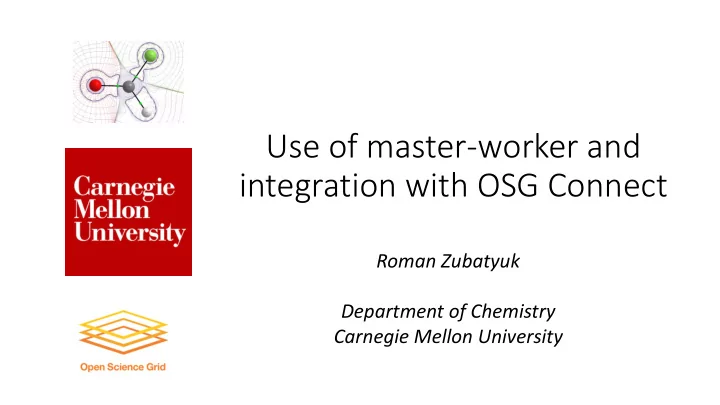

Use of master-worker and integration with OSG Connect Roman Zubatyuk Department of Chemistry Carnegie Mellon University
Supervised machine learning on quantum-chemical data ML QM Unique Predicted QM Molecular Property Energy & Representation Properties Database of calculated QM energies and properties for 50M molecules • Traditional quantum mechanics: Slow calculations, one molecule at a time • QSAR: Statistical modeling of historical experimental data • Now we could use accumulated historical QM data to train a statistical models that can accurately predict results of quantum mechanics J. Smith, O. Isayev, A. Roitberg. Chem. Sci. , 2017, 8 , 3192-3203
Fast, accurate, transferable and extensible neural network potentials ANI1: 20M DFT calculations (CHNO) ANI-1x: 5M DFT calculations (CHNO) ANI-1ccx: 0.5M CCSD(T)/CBS (CHNO) ANI-2x, AIMNet: 9M DFT calculations (CHNOSFCl) Current development: more chemical elements, charged molecules. Smith, Justin S., Olexandr Isayev, and Adrian E. Roitberg. "ANI-1: an extensible neural network potential with DFT accuracy at force field computational cost." Chemical science 8.4 (2017): 3192-3203. Smith, Justin S., et al. "Less is more: Sampling chemical space with active learning." The Journal of chemical physics 148.24 (2018): 241733. Smith, Justin S., et al. "Approaching coupled cluster accuracy with a general-purpose neural network potential through transfer learning." Nature communications 10.1 (2019): 2903. Zubatyuk, Roman e t al., “Accurate and Transferable Multitask Prediction of Chemical Properties with an Atoms-in-Molecules Neural Network .” Sci. Adv. 2019, 5 (8), eaav6490.
Our computational tasks • DFT calculations for small molecules (ORCA) • Semiempirical molecular dynamics (XTB) • Molecular docking (AutoDock Vina) • ~ 10 4 – 10 6 tasks • Short (20s - 2h CPU time) • Small input size (1 – 100 kb) • Portable software stack => Ideal for OSG “Free” opportunistic computational resource Single core, small memory, small disk, short run time.
Standard workflow • Create inputs for tasks, transfer to submit host. ~ 10 6 tasks • Transfer to submit host group several tasks together: all done or all fail • Write job execution script • Submit to Condor (or SLURM) • Wait • Resubmit failed tasks Master-worker workflow • Put tasks to a master database. • Write script to perform single task • Launch workers what execute tasks. • Workers communicate with the master (get task, put results) Data are organized, tasks are independent, computer resource use is efficient Easy to use
Master-worker implementation • Message queue database (message == task) • Consumers execute tasks ( each message should be delivered only once) • Implemented RQ ( Redis Queue ) Python library • Other alternatives are Celery, Huey2, Dramatiq, Ray, Uber Cherami, and many more. • We did not re-invented the wheel. We made a wheel without bells and whistles that fits our vehicle: • RQ is simple, scalable and customizable • RQ workers need very basic environment • Tasks are simple Python functions • Single-user environment
Task life cycle ➢ configure environment (application software) • if jobs in Redis and few Condor jobs: • get next job from Redis || die • ssh osgconnect condor_submit • get extra job data from Redis • sleep • execute job • repeat • parse results • get MongoDB records • return results • create RQ jobs Condor • repeat Submit RQ Submit Worker Worker Redis Worker MongoDB Worker Worker Collect User interface: • Put data to MongoDB • get completed RQ jobs rq_submit <query> <job function name> <parameters> • • write results to MongoDB rq info for status of jobs and workers • • sleep • Find results in MongoDB • repeat
Job definition file campaign: wb97mv campaign_config: <- job function (run ORCA) func_name: htrq.htrun.scripts.orca.sequential job_timeout: 15000 args: - name: wb97md3bj route: | ! wB97m-d3bj def2-tzvpp def2/j rijcosx engrad tightscf %elprop dipole true quadrupole true end <- what to compute (energy & gradient) %output PrintLevel mini Print[P_DFTD_GRAD] 1 end %scf maxiter 256 end parsers: stdout: - htrq.htrun.parser.orca.total_energy <- how to parse data - htrq.htrun.parser.orca.gradient - htrq.htrun.parser.orca.dipole keep_files: stdout: '{id}_wb97md3bj.out' <- some results could be stored on file system instead of MongoDB orca.gbw: '{id}_wb97md3bj. gbw’ kwargs: mongo_output_key: wb97mv <- how to store results in MongoDB submit: query: wb97mv.wb97md3bj: null <- how to select and submit jobs projection: [] queue: orca:high
RQ job data • Database, ID • Input data (coordinates of atoms, etc.) • Job Python function (e.g. DFT energy + gradient calculation) • Redis key containing parameters of job function (e.g. DFT functional and basis set) => Unique job ID Worker environment • Python 3.5+ ( OCG Connect CVMFS) • python-rq and python code to execute task ( OSG Connect Stash < 10 MB) • Application software binaries ( OSG Connect Stash < 500 MB)
Performance of RQ • MongoDB, Redis, submit and collect scripts on a single mid-grade workstation (i7, 32GB RAM) • 10M tasks in Redis Queue • 10,000 workers at a time (probably, could be few times more) • 100 jobs/sec • 1 Gbps sustained incoming network traffic to Redis About 20 M CPU core hours consumed on OSG, XSEDE and TACC Frontera with same RQ-based framework!
Acknowledgements Funding: CHE-1802789 HPC Computing:
Recommend
More recommend